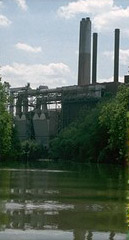Pollution
To learn more about the major threats to aquatic biodiversity please select from the following:
Oceans have historically been the dumping grounds for the wastes from society. Fortunately, this view has changed and regulations have become much more stringent, but the effects of the past still linger. Pollution has been very damaging to aquatic ecosystems, and may consist of agricultural, urban, and industrial wastes containing contaminants such as sewage, fertilizer, and heavy metals that have proven to be very damaging to aquatic habitats and species.

Many of the pollutants entering aquatic ecosystems (e.g., mercury lead, pesticides, and herbicides) are very toxic to living organisms. They can lower reproductive success, prevent proper growth and development, and even cause death. The organisms that are most directly and adversely affected by toxic pollutants consist of larvae, eggs, and other organisms that live at the surface or near the bottom of aquatic habitats where pollutants tend to settle. Filter feeders (e.g., clams, and mussels) and other organisms higher up in the food chain (e.g., swordfish, tuna) are also affected by the presence of toxicants. Filter feeders and predatory fin-fish are not directly affected by the presence of toxic chemicals in the water column or sediments. Instead they bioconcentrate and bioaccumulate the toxicants. For example, humans, animals, and birds have been known to suffer from mercury poisoning, lead poisoning, and other neurological diseases from eating fish and shellfish that are contaminated with high levels accumulated toxicants.

In addition to toxic pollutants, increased nutrients, especially nitrogen and phosphorus, from city sewage and fertilizers from agricultural areas (e.g. animal feed lots) have also proven to be very damaging to aquatic ecosystems. Certain levels of these nutrients are known to cause harmful algal blooms in both freshwater and marine habitats. In turn, algal blooms impact aquatic biodiversity by affecting water clarity, depleting oxygen levels, and crowding out organisms within an ecosystem. In some instances algal blooms have produced neuro-toxins that have led to species die-offs and illnesses such as paralytic shellfish poisoning.
Other pollutants affecting biodiversity in aquatic ecosystems are solid pollutants like plastic bags, plastic rings, abandoned fishing gear, and other man-made materials that result from garbage dumped from shore and ships. Trash and debris of this nature floating in aquatic environments, have been known to entangle and even kill marine mammals and birds. Animals such as sea turtles have often died through ingesting bits of plastic and other discarded materials. In addition, abandoned fishing gear such as lobster pots and nets are self-baiting and will continue to catch and kill fish and other organisms for years after the gear has been discarded or lost.

Tanker accidents have contributed to oil pollution in marine environments. The ecological consequences of these oil spills in marine systems have been quite severe. It is well documented that oil has a lethal effect on eggs and larvae, seabirds, and any many other surface dwellers (including larvae of commercially important species) through asphyxiation and poisoning effects. Oil exposure can also cause the loss of fur and feathers among mammals and birds resulting in hypothermia and can also inhibit them from eating, which can also be fatal.
Additional Resources
- USEPA's Office of Water Nonpoint Source Pollution
- USEPA's Regional Vulnverability Assessment (ReVA)
- USEPA's Information Web on Pollutants and Toxics
- Air
Toxics in the Great Lakes Region at the Great Lakes Information Network

- Toxic
Contamination in the Great Lakes

- WWF
Toxic Chemicals – Agricultural Pesticide Pollution
 and Persistent Organic Pollutants
and Persistent Organic Pollutants 
- EPA Office of Pollution Prevention and Toxics
- UNEP - Global Marine Oil Pollution Information Gateway

- Environment
Canada - Effects of environmental pollutants on biodiversity

![[logo] US EPA](https://webarchive.library.unt.edu/eot2008/20081111080037im_/http://www.epa.gov/epafiles/images/logo_epaseal.gif)